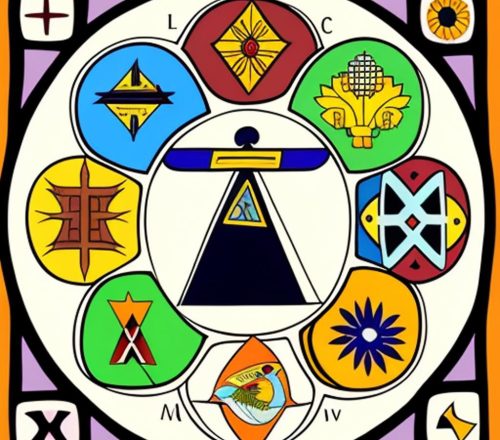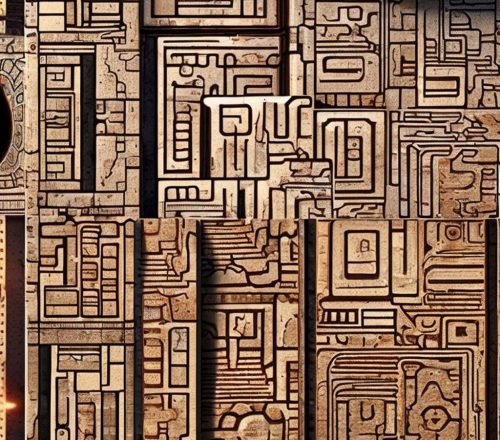
Table of Contents
The Game of the Palm and the Game of Hounds and Jackals
The Game of the Palm and the Game of Hounds and Jackals are two distinct ancient board games, each with unique characteristics and historical contexts. Here’s a detailed comparison between them:
Game of the Palm (also known as the Royal Game of Ur)
Overview
- Origin: The Game of the Palm, commonly referred to as the Royal Game of Ur, dates back to the Early Dynastic period of Mesopotamia (around 2600 BCE).
- Discovery: The game was discovered in the Royal Tombs of Ur, an archaeological site in modern-day Iraq.
- Board Design: The game board typically consists of two sets of 4 x 3 squares connected by a short bridge of two squares, forming a total of 20 squares.
- Pieces and Dice: Players used seven markers each, typically conical or pyramidal in shape, and four-sided dice or tetrahedral dice.
Gameplay
- Objective: The goal of the game was to navigate all seven of one’s pieces from the starting point to the endpoint, following a specific path marked on the board.
- Movement: Players rolled the dice to determine the number of squares to move their pieces.
- Special Squares: Certain squares on the board were marked with rosettes or other symbols, indicating safe zones or special actions like extra turns.
Cultural Significance
- Recreational and Divinatory Use: While primarily a game of skill and chance, it also held religious and divinatory significance, similar to many ancient games.
- Burial Context: The game boards were often found in royal tombs, suggesting their importance in the afterlife and as part of funerary practices.

Game of Hounds and Jackals (also known as the Game of 58 Holes)
Overview:
- Origin: The Game of Hounds and Jackals, or the Game of 58 Holes, dates back to the Middle Kingdom of Egypt (around 2000 BCE).
- Discovery: The game was found in various archaeological sites, including Thebes and Mesopotamia.
- Board Design: The board features two parallel rows of 29 holes each, making a total of 58 holes. It often included decorative elements like hounds and jackals carved into the board.
- Pieces and Dice: The game used 10 pegs or pawns (five for each player), often shaped like hounds and jackals, along with dice or knucklebones.
Gameplay:
- Objective: The aim was for players to move their pieces from one end of the board to the other, navigating all 58 holes.
- Movement: Dice or knucklebones determined the number of moves, with pieces moving according to the roll.
- Divination Aspect: The rolls were often seen as influenced by divine will, with outcomes interpreted for guidance.
Cultural Significance:
- Funerary Use: Similar to the Royal Game of Ur, Hounds and Jackals were often found in tombs, symbolizing the journey to the afterlife.
- Divination and Ritual: The game was used for divination, with moves and outcomes interpreted as divine messages.
Key Differences
- Board Design:
- Game of the Palm: 20 squares arranged in a specific layout with marked special squares.
- Hounds and Jackals: 58 holes in two parallel rows, often with decorative carvings.
- Pieces:
- Game of the Palm: Seven markers per player, often pyramidal or conical.
- Hounds and Jackals: Five pegs per player, typically shaped like hounds and jackals.
- Dice:
- Game of the Palm: Used four-sided or tetrahedral dice.
- Hounds and Jackals: Used dice or knucklebones.
- Historical and Geographical Context:
- Game of the Palm: Originated in Mesopotamia, specifically the Royal Tombs of Ur.
- Hounds and Jackals: Originated in Egypt, with findings in multiple Near Eastern sites.
- Cultural Role:
- Both games had recreational, divinatory, and funerary significance, but the specific interpretations and rituals surrounding them varied according to the respective cultural contexts.
These distinctions highlight the rich diversity of ancient board games and their profound roles in the societies that created and played them.
How many players were involved in those games
Both the Royal Game of Ur (Game of the Palm) and the Game of Hounds and Jackals (Game of 58 Holes) were typically two-player games. Here’s a more detailed look at the player involvement in each:
Royal Game of Ur (Game of the Palm)
- Players: The game was designed for two players.
- Gameplay Interaction: Each player had a set of seven pieces that they would move across the board based on the roll of dice. Players took turns rolling the dice and moving their pieces.
- Competitive Nature: The game was competitive, with each player trying to be the first to navigate all their pieces from the starting point to the endpoint. Pieces could be captured and sent back to the start, adding a strategic layer to the gameplay.
Game of Hounds and Jackals (Game of 58 Holes)
- Players: This game was also intended for two players.
- Gameplay Interaction: Each player had five pieces, shaped like hounds and jackals, which they would move along the board based on the roll of dice or knucklebones.
- Competitive Nature: Similar to the Royal Game of Ur, players competed to be the first to move all their pieces from one end of the board to the other. The movement was dictated by the roll of dice, and the gameplay involved both chance and strategy.
Summary
Both the Royal Game of Ur and the Game of Hounds and Jackals were typically two-player games, emphasizing direct competition and strategic movement of pieces. The two-player format facilitated a face-to-face interaction that was common in many ancient board games, allowing for a dynamic and engaging gameplay experience.
Shop Corner
Hounds and jackals game on Amazon
Ancient Egyptian games on Amazon
Enjoy the readings! Thanks for shares and comments ?
Take time to learn
Invest in your future
Embark on a journey into the realm of affiliate marketing and craft your own website within a vibrant, supportive community. Join me in this adventure, where you can begin as a free starter and stay as long as you desire. Enjoy complimentary hosting and foundational teachings to set you on your path. For those with advanced skills, opportunities to elevate your expertise await. Take a moment to explore and witness the magic for yourself!




